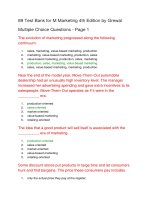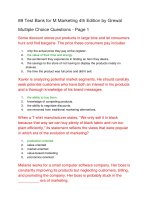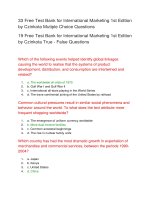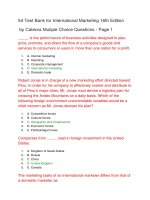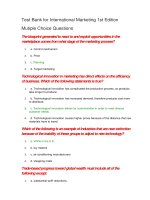Download test bank for international marketing 15th edition by cateora
Bạn đang xem bản rút gọn của tài liệu. Xem và tải ngay bản đầy đủ của tài liệu tại đây (466.67 KB, 121 trang )
Test Bank For International Marketing
15th Edition by Cateora
Chapter 02
The Dynamic Environment of International Trade
Link download full:
/>th-edition-by-cateora
True / False Questions
1. The reciprocal impact of U.S. assistance to other countries to develop their markets
and improve global trade was that the recipient countries provided funds for American
domestic infrastructure development efforts.
True False
2. The GATT became part of the World Trade Organization in 1995, with the
ratification of the Uruguay Round agreements.
True False
3. As part of the worldwide economic growth and rebuilding after World War II,
countries once classified as less developed were reclassified as underdeveloped
countries.
True False
4. As a result of the increasing global trade, the United States was able to increase its
share of the world gross national product (GNP) from less than 25 percent in 1950 to
over 39 percent in 2010.
True False
2-1
5. A nation's balance-of-payments statement records all financial transactions between
its residents and those of the rest of the world during a given period of time.
True False
6. The fact that the credit and debit side in a balance-of-payments record balance
means that a nation is in particularly good financial condition.
True False
2-2
7. The reserves account is a record of direct investment, portfolio investment, and
short-term capital movements to and from countries.
True False
8. Protection of an infant industry is recognized by economists as a valid argument in
favor of protectionism.
True False
9. A case might be made for long-term protection of markets with excess productive
capacity or excess labor when such protection could facilitate an orderly transition.
True False
10. Barriers to trade are encouraged by local industry.
True False
11. In general, tariffs decrease inflationary pressures.
True False
12. Tariffs often are used as reprisals against protectionist moves of trading partners.
True False
13. Quotas are more flexible than import licenses.
True False
2-3
14. A VER is generally imposed under the threat of stiffer quotas and tariffs being set
by the importing country if a VER is not established.
True False
2-4
15. Blocked currency is used by refusing to allow an exporter to exchange its national
currency for the buyers' currency.
True False
16. Importers who want to buy a foreign good must apply for a business permit, that is,
permission to exchange an amount of local currency for foreign currency.
True False
17. The exchange permit may stipulate an unfavorable rate of exchange depending on
the desires of the government.
True False
18. The United States and other countries require some products to contain a
percentage of "local content" to gain admission to their markets. This is an example of
how countries use antidumping rules to protect their own industries.
True False
19. Antidumping laws were designed to prevent foreign producers from "predatory
pricing."
True False
20. Among the many proposals brought forward for lowering the trade deficit, most
deal with fairness of trade with some of our trading partners instead of reducing
imports or adjusting other trade policies.
True False
2-5
21. The issue of the openness of markets for U.S. goods is addressed as market
expansion section of the Omnibus Trade and Competitiveness Act of 1988.
True False
2-6
22. Obtaining export licenses for products on the export control list is more arduous
than for those items that are exempt from the list.
True False
23. The GATT panels formed to resolve bilateral trade disputes are only advisory and
have no enforcement powers.
True False
24. The decisions of the World Trade Organization in trade dispute among members
are binding decisions.
True False
25. The World Bank was formed to overcome inadequate monetary reserves and
unstable currencies which were particularly vexing problems in global trade.
True False
Multiple Choice Questions
26. After World War II, the United States led efforts like the Marshall Plan to assist in
rebuilding Europe, financial and industrial development assistance to rebuild Japan,
and funds channeled to foster economic growth in the underdeveloped world, while
helping to create a world economy were aimed toward:
A. halting the growth of Nazi Germany.
B. dampening the spread of communism.
C. dissolving the colonial powers.
D. gaining access to the European market.
E. a worldwide trade bloc to counter the OPEC countries' clout.
2-7
27. What was the reciprocal impact of the foreign economic assistance given by the
United States?
A. European countries supplied funds for U.S. welfare programs.
B. Immigration to the U.S. from the recipient countries was reduced owing to
increased economic activity at home.
C. All recipient countries appointed Americans to manage their central banks.
D. Purchases of U.S. agricultural products, manufactured goods, and services by the
recipient countries increased.
E. The NAFTA was formed on this platform.
28. Which of the following factors was responsible for the excess production capacity
in the U.S. in the first half of the twentieth century?
A. Technological innovation revolutionized production during this time.
B. Many firms from other nations shifted their production facilities to the U.S.
C. Domestic demand was at a historic low, which produced excess capacity.
D. Swelling labor supply of returning military after World War II.
E. Influx of migrant laborers from Europe and Japan.
29. Which of the following, in addition to U.S. economic assistance, was a significant
move toward international cooperation among trading nations?
A. Forming of the United Nations Development Programme
B. Signing of the Treaty on Open Skies
C. Establishment of the World Federation of Trade Unions
D. Negotiation of the General Agreement on Tariffs and Trade
E. Signing of the Montreal Protocol
2-8
30. Which of the following acronyms refer to the international forum for member
countries to negotiate a reduction of tariffs and other barriers to trade?
A. WTO
B. GATT
C. OECD
D. OPEC
E. UNDP
2-9
31. What was the outcome for GATT, after the ratification of the Uruguay Round
agreements?
A. It came into effect retrospectively, leading to huge payment deficits for member
nations.
B. It became part of the World Trade Organization.
C. It triggered formation of competitive treaties from Asian nations.
D. The European Union decided to stay away from the treaty.
E. The original purpose was sidelined in favor of political and military intervention
between member states.
32. According to the text, which were the two major challenges U.S. multinational
corporations were facing at the close of the 1960s?
A. The rise of socialism/communism in the (former) Soviet Union and the higher
tariffs on imports
B. Growing jingoistic nationalism and a negative population growth rate in major
international markets
C. Resistance to direct investment and increasing competition in export markets
D. Increasing Chinese domination in the manufacturing sector and the falling dollar in
global markets
E. Political intervention in free trade movement and growing influence of consumer
rights advocacy in the home market
33. In the worldwide economic growth and rebuilding after World War II, countries
once classified as less developed were reclassified as ___.
A. greenfield countries
B. growth economies
C. tier-II countries
D. developing countries
E. newly industrialized countries
2-10
34. Which of the following is the correct picture of the outcome of increased world
trade after the 1950s, contrary to Servan-Schreiber's prediction?
A. Third World countries were excluded from this economic growth, thus leading to
stark imbalances in wealth.
B. The European Union became the center of world trade, taking the position away
from the U.S.
C. Japan became the dominant player in the world market, beating American and
European multinationals.
D. Economic power and potential became more evenly distributed among countries.
E. Americans were able to reiterate their dominance in world trade through direct
investment and growing exports.
35. The World Bank estimates that five countries whose share of world trade is barely
one-third that of the European Union will, by 2020, have a 50 percent higher share
than that of the European Union. Which of the following is NOT one of those five
countries?
A. Brazil
B. China
C. India
D. Indonesia
E. Rhodesia
36. The United States has many successful trade relationships. Four of these
relationships account for a tremendous volume of trade. All of the following countries
are among the top trade partners for the U.S. EXCEPT:
A. Canada
B. Mexico
C. Japan
D. India
E. China
2-11
37. After World War II, United States set out to infuse the ideal of capitalism
throughout as much of the world as possible through efforts like the _____ which was
aimed at assisting in rebuilding Europe.
A. Eisenhower Plan
B. Marshall Plan
C. Bradley Plan
D. Roosevelt Plan
E. Truman Plan
38. With respect to the nationality of the world's 100 largest industrial corporations,
the United States is home to the largest number of the top 100 firms. Which of the
following countries is home to the second largest number of these firms?
A. Germany
B. United Kingdom
C. France
D. Netherlands
E. Japan
39. After 1888, the United States had unparalleled growth and a favorable balance of
trade until ___. After this date, the United States has a negative balance of trade.
A. 1950
B. 1963
C. 1968
D. 1971
E. 1985
2-12
40. In 2007 this country ranked second behind the United States in the ranking of the
world's largest corporations.
A. Netherlands
B. Japan
C. France
D. Germany
E. South Korea
2-13
41. The system of accounts that records a nation's international financial transactions is
called its:
A. trade balance.
B. national accounts system.
C. EX-IM (exports-imports) account.
D. balance of payments.
E. exchange rate.
42. Which of the following ensures that balance-of-payments records are always in
balance?
A. The balance sheet record
B. The ledger entry model
C. A double-entry bookkeeping system
D. A deficit-surplus record system
E. An import/export bookkeeping system
43. Which of the following is true regarding balance-of-payments records?
A. The fact that assets and liabilities balance means a nation is in particularly good
financial condition.
B. The fact that assets and liabilities balance does not mean a nation is in particularly
poor financial condition.
C. A balance of payments is not a record of condition.
D. A balance of payments is a determinant of condition.
E. A balance of payments reflects all the financial transactions that occurred in the
country.
2-14
44. A nation's balance-of-payments statement records all financial transactions
between:
A. its member states and its primary trading partners.
B. its residents and those of the rest of the world during a given period of time.
C. its suppliers and receivers.
D. profit and nonprofit organizations over a five-year period of time.
E. its top 100 companies and the global top 100 companies.
2-15
45. A balance-of-payments statement includes three accounts. Two of those accounts
are the current account and the capital account. What is the third account found on the
balance-of-payments statement?
A. Investment account
B. Receivables account
C. Services account
D. Credit account
E. Reserves account
46. Which of the following would be the balance-of-payments account that is a record
of all merchandise exports, imports, and services plus unilateral transfers of funds?
A. Current account
B. Capital account
C. Credit account
D. Receivables account
E. Reserves account
47. The marketing manager for Healthy Horse Products wants to export to Australia
but learns the labeling requirements are quite difficult to comply with limiting imports.
This is a type of:
A. blockage.
B. protectionism.
C. trade refusal.
D. stonewalling.
E. boycotting.
2-16
48. Which of the following arguments regarding protections is recognized by
economists as valid?
A. Need to keep money at home
B. Encouragement of capital accumulation
C. Protection of an infant industry
D. Conservation of natural resources
E. Maintenance of employment and reduction of unemployment
2-17
49. All of the following would be considered to be reasons for adopting an attitude of
protectionism with respect to world trade EXCEPT:
A. to protect political stability.
B. protection of an infant industry.
C. protection of a home market.
D. the need to keep money at home.
E. to encourage capital accumulation.
50. Randall Smithe-Jones believes that protectionism is the only way to save the
United Kingdom from outside competitors. He has seen small business after small
business go bankrupt because cheaper foreign goods have been more popular. The UK
has just started a cell-phone manufacturing industry and Smithe-Jones' company is one
of the first to try their hand at cell-phone manufacturing. Which of the following
would probably be the argument that Smithe-Jones would use to persuade his
government representatives that protectionism is still needed in the U.K.?
A. Protection of an infant industry
B. The need to keep money at home
C. Conservation of natural resources
D. National defense
E. The industrialization of a low-wage nation
51. Section 301 of the Omnibus Trade and Competitiveness Act authorizes the U.S.
government to _____ and _____ against specific foreign trade barriers judged to be
unfair.
A. suppress, attack
B. educate, substantiate
C. investigate, retaliate
D. market, dominate
E. litigate, retaliate
2-18
52. A(n) _____ is simply a tax imposed by a government on goods entering at its
borders.
A. quota
B. trade penalty
C. tariff
D. boycott
E. embargo
2-19
53. In general, tariffs weaken:
A. inflationary pressures.
B. special interests' privileges.
C. balance-of-payments positions.
D. government control in economic matters.
E. reciprocal tariffs by other countries.
54. In general, tariffs restrict:
A. inflationary pressures.
B. special interests' privileges.
C. government control in economic matters.
D. the number of tariffs.
E. manufacturers' supply sources.
55. A specific unit or dollar limit applied to a particular type of good is called a(n):
A. tariff.
B. quota.
C. standard.
D. embargo.
E. boycott.
56. All of the following would be considered to be nontariff barriers that could be
erected to restrict trade EXCEPT:
A. quotas.
B. taxes.
C. packaging requirements.
D. border taxes.
E. embargoes.
2-20
57. Which of the following types of nontariff barriers would be considered to be
"specific limitations on trade" by international marketers?
A. Fees
B. Export subsidies
C. Voluntary export restraints
D. Embargoes
E. Packaging, labeling, or marking standards
58. Cybil Chan has been asked by her company to review a series of published
nontariff barriers that is used by the Hong Kong Port Authority to control customs and
administrative entry procedures. Which of the following nontariff barriers should Ms.
Chan look for under the category called customs and administrative entry procedures?
A. Orderly marketing agreements
B. Voluntary export restraints
C. Countervailing duties
D. Export subsidies
E. Documentation requirements
59. Exporting countries sometimes agree to voluntary export restraints (VER) as an
alternative to the threat of:
A. expulsion.
B. disorderly marketing agreements.
C. stiffer quotas and tariffs.
D. export subsidies.
E. standardization disparities.
2-21
60. An agreement between the importing country and the exporting country for a
restriction on the volume of exports is called a(n):
A. tariff.
B. standards option.
C. voluntary export restraint(VER).
D. trade block.
E. documentation requirement.
2-22
61. Which of the following is true regarding VERs?
A. International regulatory bodies set export/import limits.
B. The importing sets the trade limits for import.
C. The exporting country sets the limits.
D. It is a common reaction to lenient tariffs and quotas by the importing country.
E. A VER is established in agreement with the importing country.
62. When the United States refuses to sell goods to Iran because of the perception that
the country harbors radicals and terrorists, the refusal is called a(n):
A. boycott.
B. embargo.
C. tariff.
D. orderly market agreement.
E. currency block.
63. _____ is accomplished by refusing to allow importers to exchange its national
currency for the seller's currency.
A. Boycotted money
B. Embargoed capital
C. Blocked currency
D. Anti-banking
E. Cartel dissolution
64. In order to secure foreign exchange, which of the following is used by countries
experiencing severe shortages of foreign exchange?
A. Import quotas
B. Government approval
C. Tariffs
D. Blocked currency
E. Differential exchange rates
2-23
65. Which of the following trade policy tools requires the importers who want to buy a
foreign good to apply for an exchange permit?
A. Tariffs
B. Import quota
C. Blocked currency
D. Government approval
E. Export levies
66. Which of the following can the exchange permit stipulate?
A. The quantity of goods that can be exchanged for a particular sum of foreign
currency
B. The number of parties that can be involved in an exchange transaction
C. The amount to be exchanged to be deposited in a local bank
D. The parties involved to declare collaterals to avail of exchange permits
E. The number of times one party can avail of exchange permits
67. Tall Pine Plywood Company has just received notice that a shipment of plywood
(2 metric tons) has been rejected by Japanese customs because the knotholes
commonly found on a plywood sheet are too large. This would be an illustration of
which of the following nontariff barriers to trade?
A. Quota
B. Predatory pricing
C. Embargo
D. Boycott
E. Standards
2-24
68. The United States and other countries require some products (automobiles in
particular) to contain a percentage of "local content" to gain admission to their
markets. This is an example of the usage of _____ to restrict trade.
A. exchange permits
B. quotas
C. tariffs
D. standards
E. antidumping penalties
2-25

